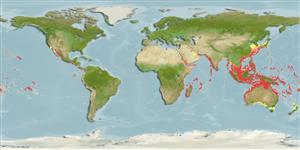Common names from other countries
Environment: milieu / climate zone / depth range / distribution range
Écologie
Récifal; profondeur 0 - 133 m (Ref. 100991). Tropical
Indo-Pacific: East and South Africa to eastern Polynesia.
Length at first maturity / Taille / Poids / Âge
Maturity: Lm ? range ? - ? cm Max length : 9.5 cm SHL mâle / non sexé; (Ref. 349); common length : 4.0 cm SHL mâle / non sexé; (Ref. 349)
Length based on occurrence record; to be replaced with better reference. Usually found under slabs and small corals (also Ref. 799), frequently occurring in groups (Ref. 349). Also found in shallow subtidal waters (Refs. 349, 2925). Dead shells found on the beaches (Ref. 88739). Members of the family Cypraeidae are primarily carnivores (Ref. 67623).
Life cycle and mating behavior
Maturité | Reproduction | Frai | Œufs | Fécondité | Larves
Members of the order Neotaenioglossa are mostly gonochoric and broadcast spawners. Life cycle: Embryos develop into planktonic trocophore larvae and later into juvenile veligers before becoming fully grown adults.
Poutiers, J.M. 1998. (Ref. 349)
Statut dans la liste rouge de l'IUCN (Ref. 130435)
statut CITES (Ref. 108899)
Not Evaluated
Not Evaluated
Menace pour l'homme
Harmless
Utilisations par l'homme
Pêcheries: commercial
| FishSource |
Outils
Plus d'informations
Taille/ÂgeCroissanceLongueur-poidsLongueur-longueurMorphologieLarvesAbondance
Sources Internet
Estimates based on models
Preferred temperature
(Ref.
115969): 22.5 - 29.1, mean 28 (based on 2376 cells).
Vulnérabilité
Low vulnerability (10 of 100).
Catégorie de prix
Unknown.
